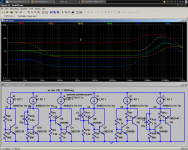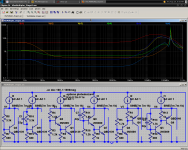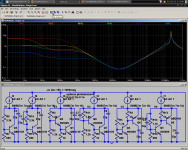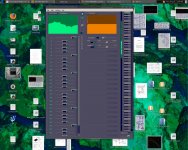All rigth, a peace treat signed.... PM unblocked for kind future communications
Apologizes from both sides, and we should be happy and extend hand one each other and go ahead alike brothers, as both of us are important to the forum..we are rarities..we do things!
regards.
Carlos
Apologizes from both sides, and we should be happy and extend hand one each other and go ahead alike brothers, as both of us are important to the forum..we are rarities..we do things!
regards.
Carlos
Mr. Self likes 22u , I use a 22u presently. I have seen anywhere between 47u and .1u on commercial designs. As we are just decoupling a simple shunt regulator, "just adequate" quality will do ... no blackgates on my Vbe , please. 😀but that never happens in this industry 😀
does C86 need to be 22uF - a smaller value allows use of a higher quality cap ?
OS
Last edited:
Apologizes from both sides, and we should be happy and extend hand one each other and go ahead alike brothers, as both of us are important to the forum..we are rarities..we do things!
regards.
Carlos
No problem Carlo's , this is good. I never wanted for this , one thing led to another. We still must build up to the "brother" level , this takes time. 🙂
OS
Mr. Self likes 22u , I use a 22u presently. I have seen anywhere between 47u and .1u on commercial designs. As we are just decoupling a simple shunt regulator, "just adequate" quality will do ... no blackgates on my Vbe , please. 😀
OS
Ahh, more guessing 😡 the quality of the cap does matter , more tommorrow..
Yes, Pete,
It DOES matter, and a 22uF 6.3VW BG NX cap in this position DOES sound superior.
Which irks me, because they take time to bed down, and they are EXPENSIVE.
Smiles all round....
Hugh
It DOES matter, and a 22uF 6.3VW BG NX cap in this position DOES sound superior.
Which irks me, because they take time to bed down, and they are EXPENSIVE.
Smiles all round....
Hugh
Yes, Pete,
It DOES matter, and a 22uF 6.3VW BG NX cap in this position DOES sound superior.
Which irks me, because they take time to bed down, and they are EXPENSIVE.
Smiles all round....
Hugh
I read that they are no longer in production. 🙁 Where I do see them is in esoteric "audiohaus's".. where they want your soul in return
 . They are made with carbon "doped" electrolyte , right ?? Have you researched an alternative ??
. They are made with carbon "doped" electrolyte , right ?? Have you researched an alternative ??OS
No, not at this stage. But I bought quite a few about five years ago, and still have some left, which I treasure. They are very useful for the ultimate low noise application.
It is never nice to be reminded that some of these audiophool components are actually very, very good. I have found that electros specced to 100KHz for switch mode use are excellent for audio, and well priced. UCC make such a range.
Hugh
It is never nice to be reminded that some of these audiophool components are actually very, very good. I have found that electros specced to 100KHz for switch mode use are excellent for audio, and well priced. UCC make such a range.
Hugh
No, not at this stage. But I bought quite a few about five years ago, and still have some left, which I treasure. They are very useful for the ultimate low noise application.
It is never nice to be reminded that some of these audiophool components are actually very, very good. I have found that electros specced to 100KHz for switch mode use are excellent for audio, and well priced. UCC make such a range.
Hugh
Funny you mention 100k , I was sourcing the signal path caps and came across these from panasonic (the EE or FM series) http://www-images.panasonic.com/industrial/components/pdf/ABA0000CE108.pdf
for modern switching apps. and cheap , Mouser has them (33u@35vfor $.11) very low impedance at HF.
OS
Peter,
Just as they did with transistors, the Japanese are now producing some of the best caps, too. That big passive components manufacturer based in Philly had better watch out!!
Hugh
Just as they did with transistors, the Japanese are now producing some of the best caps, too. That big passive components manufacturer based in Philly had better watch out!!
Hugh
Os I was thinking of asking keantoken to sim a vbe multiplier using a darlington and make the same comparison he did in the aksa thread. Im trying to find transistor models for the darlington at the moment. I dont really know what to say about the outputstage, In all the years I still havent built anything with quasy outputstages.
I don't know if having a model for the darlington will matter, a 2N5089 driving the usual transistor used here would probably work.
But if I were to predict, I would say that the results at AC won't be much different than those of the C-B capacitor mod. In both cases a hurdle overcome is the Ib of the transistor. The Darlington uses a whole other device to fix this, with little impact on other factors. For instance, the resistor network reduces OLG of the stage by its ratio. The cap mod fixes this as well as the Ib problem by adding only 1 passive component.
Gm is still the same, which is the second hurdle. Compared with the cap mod, using a darlington is still worse, and with the cap mod added to the darlington, performance is still about the same.
A better option is to use CFP instead. This reduces Gm as well as Ib, and sims much better. Add the cap mod and it works wonders.
Sims to follow, let's see if I'm right.
- keantoken
impedance range ~ 0.8ohms to 200ohms.
Can I assume that lower AC impedance is better for a Vbe multiplier?
Why is V2 the lowest impedance between 7MHz and 280MHz?
Does that matter in an audio amp?
What effect does adding the bypass cap have on each?
Can I assume that lower AC impedance is better for a Vbe multiplier?
Why is V2 the lowest impedance between 7MHz and 280MHz?
Does that matter in an audio amp?
What effect does adding the bypass cap have on each?
Lower impedance is better, as far as I can tell.
At the frequencies you describe, adding any more active components will only degrade performance in my experience. This is why the single-transistor version works so well there.
The darlington doe have better DC impedance, but CFP is most "bang for buck". Although instability might tip the scales a bit.
I'll add a bypass cap, 22uF .02ohms 22uH and see how that goes.
- keantoken
At the frequencies you describe, adding any more active components will only degrade performance in my experience. This is why the single-transistor version works so well there.
The darlington doe have better DC impedance, but CFP is most "bang for buck". Although instability might tip the scales a bit.
I'll add a bypass cap, 22uF .02ohms 22uH and see how that goes.
- keantoken
Wait a sec, I neglected cap parasitics the first time around. The first plot are the results. This assumes .075ohms ESR, 22nH ESL, 22uF. ESL is worst-case.
Second plot adds the same spec'd caps as bypass. I thought the spike would be worse, since using the same caps adds the same resonances, and the caps will resonate supposedly, but it turns out the resonance comes from the 22nH resonating with the BD139's Cob.
BTW, OS, how do I upload to the site? I made a digital instrument that sounds really nice with Bach, which I'd like to share (It's somewhere between a harp, harpsichord, guitar, and piano). Think "Switched-On Bach" except with only one instrument. I thought I'd upload a few and if there was interest I could upload more.
- keantoken
Second plot adds the same spec'd caps as bypass. I thought the spike would be worse, since using the same caps adds the same resonances, and the caps will resonate supposedly, but it turns out the resonance comes from the 22nH resonating with the BD139's Cob.
BTW, OS, how do I upload to the site? I made a digital instrument that sounds really nice with Bach, which I'd like to share (It's somewhere between a harp, harpsichord, guitar, and piano). Think "Switched-On Bach" except with only one instrument. I thought I'd upload a few and if there was interest I could upload more.
- keantoken
Attachments
Wait a sec, I neglected cap parasitics the first time around. The first plot are the results. This assumes .075ohms ESR, 22nH ESL, 22uF. ESL is worst-case.
Second plot adds the same spec'd caps as bypass. I thought the spike would be worse, since using the same caps adds the same resonances, and the caps will resonate supposedly, but it turns out the resonance comes from the 22nH resonating with the BD139's Cob.
BTW, OS, how do I upload to the site? I made a digital instrument that sounds really nice with Bach, which I'd like to share (It's somewhere between a harp, harpsichord, guitar, and piano). Think "Switched-On Bach" except with only one instrument. I thought I'd upload a few and if there was interest I could upload more.
- keantoken
So.. the single transistor vbe with the cap mod is the winner. 🙂 You can upload here : HFS / This is the "root" of the server. Click the upload folder , a upload button appears on the top right .. then , just like DIYA "manage attachments" , 10 "choose file" buttons appear. Digital instruments are cool 😎 , check out my signal generator/instrument (below) Could not blow the "supersym" even with all those waves. 😀
OS
Attachments
is it the complex impedance of C1 or C4 that causes the resonant peak?
What value of resistor and where to damp?
What value of resistor and where to damp?
A 33 ohm resistor in series with C1 or the "cap mod" works. That is assuming that by the time the amp is on the PCB, we will have any control over resonances at 200MHz!
The file is uploaded! Look in the Uploads folder at OS's website for BWV973.mp3, and please tell me what you think! I may be able to improve the sound by rendering differently.
- keantoken
The file is uploaded! Look in the Uploads folder at OS's website for BWV973.mp3, and please tell me what you think! I may be able to improve the sound by rendering differently.
- keantoken
That is assuming that by the time the amp is on the PCB, we will have any control over resonances at 200MHz!
This is probably a stupid question but isn't that just academic anyways?
- Home
- Amplifiers
- Solid State
- The MONGREL (supersym II)




